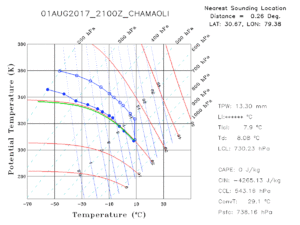Ashwin D
Hello,
I have this Tphigram and I have read this document - https://courses.eas.ualberta.ca/eas370/The-Tephigram.pdf but it is not instantly clear whether this sounding reveals impending rainfall or not. Can somebody with experience in interpreting T phi grams explain the blue , green and red lines ? I understand CAPE or CIN is not favorable and I understand what LCL means as well. But the blue, green and read line seem a bit opaque.
Can somebody explain it out ?
Regards,
Ashwin.
I have this Tphigram and I have read this document - https://courses.eas.ualberta.ca/eas370/The-Tephigram.pdf but it is not instantly clear whether this sounding reveals impending rainfall or not. Can somebody with experience in interpreting T phi grams explain the blue , green and red lines ? I understand CAPE or CIN is not favorable and I understand what LCL means as well. But the blue, green and read line seem a bit opaque.
Can somebody explain it out ?
Regards,
Ashwin.

